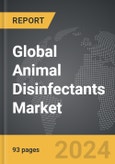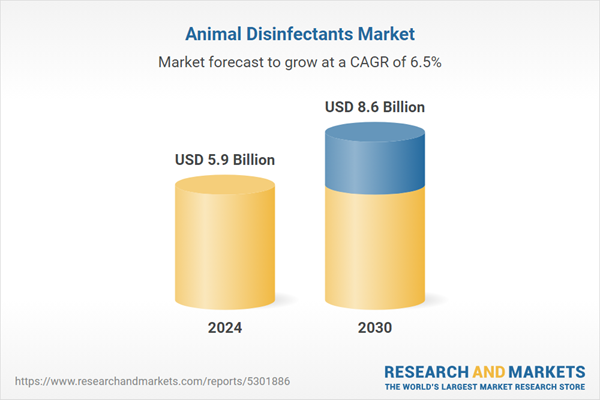The global market for Animal Disinfectants was valued at US$5.9 Billion in 2024 and is projected to reach US$8.6 Billion by 2030, growing at a CAGR of 6.5% from 2024 to 2030. This comprehensive report provides an in-depth analysis of market trends, drivers, and forecasts, helping you make informed business decisions. The report includes the most recent global tariff developments and how they impact the Animal Disinfectants market.
Segments: Type (Iodine, Lactic Acid, Hydrogen Peroxide, Phenolic Acid, Peracetic Acid, Quaternary Compounds, Chlorine, Other Types); Form (Liquid, Powder); Application (Dairy Cleaning, Swine, Poultry, Equine, Other Applications).
Geographic Regions/Countries: World; United States; Canada; Japan; China; Europe (France; Germany; Italy; United Kingdom; Spain; Russia; and Rest of Europe); Asia-Pacific (Australia; India; South Korea; and Rest of Asia-Pacific); Latin America (Argentina; Brazil; Mexico; and Rest of Latin America); Middle East (Iran; Israel; Saudi Arabia; United Arab Emirates; and Rest of Middle East); and Africa.
The analysts continuously track trade developments worldwide, drawing insights from leading global economists and over 200 industry and policy institutions, including think tanks, trade organizations, and national economic advisory bodies. This intelligence is integrated into forecasting models to provide timely, data-driven analysis of emerging risks and opportunities.
Global Animal Disinfectants Market - Key Trends and Drivers Summarized
What Are Animal Disinfectants, And Why Are They Critical In Livestock And Veterinary Care?
Animal disinfectants are specialized chemical solutions designed to eliminate harmful microorganisms such as bacteria, viruses, fungi, and parasites that can spread diseases among animals. These disinfectants are essential in maintaining the health and welfare of livestock, pets, and other animals by controlling the spread of infections in farms, veterinary clinics, and animal shelters. They are particularly vital in environments where animals are housed in close proximity, as pathogens can easily spread through direct contact, surfaces, equipment, or water sources. Disinfectants used in these settings must be potent enough to eliminate pathogens without harming the animals or leaving harmful residues in their surroundings. Whether used in livestock pens, poultry farms, or pet grooming facilities, animal disinfectants are crucial for preventing outbreaks of contagious diseases such as foot-and-mouth disease, avian influenza, and even zoonotic diseases that can potentially be transmitted to humans. As the global demand for animal products grows and concerns over food safety and animal health intensify, the importance of these disinfectants in agricultural and veterinary practices continues to increase.How Do Animal Disinfectants Support Disease Prevention In Livestock And Companion Animals?
Animal disinfectants play a key role in safeguarding both livestock and companion animals by preventing the spread of disease in environments where animals are frequently exposed to pathogens. In livestock farming, biosecurity is a top priority, and disinfectants are a core part of protocols designed to keep animals free from harmful infections. These disinfectants are often applied to surfaces, equipment, and even water supplies to ensure that animals are not exposed to harmful microorganisms. Poultry farms, for example, use disinfectants to sanitize barns, hatcheries, and feeding systems to prevent the spread of diseases such as salmonella and Newcastle disease. In dairy farms, disinfectants are used to clean milking equipment, reducing the risk of mastitis and ensuring the milk supply remains safe. Beyond agricultural applications, animal disinfectants are also important in the care of companion animals. Veterinary clinics, pet boarding facilities, and shelters rely on disinfectants to maintain sanitary conditions and prevent the spread of common infections like kennel cough, ringworm, or feline parvovirus. Regular disinfection helps reduce the risk of outbreaks that could otherwise lead to significant animal losses, healthcare costs, and in some cases, cross-species transmission of diseases.What Are The Types Of Animal Disinfectants, And How Do They Differ?
Animal disinfectants come in a variety of formulations, each tailored to specific pathogens and environments. The most common types include chemical disinfectants such as quaternary ammonium compounds (quats), phenols, iodine-based solutions, chlorine compounds, and peroxides. Quaternary ammonium compounds are widely used in veterinary clinics and farm settings because of their broad-spectrum effectiveness against bacteria, fungi, and viruses, while being generally safe for animals and humans. Iodine-based disinfectants, often used in dairies, are particularly effective against bacterial infections like mastitis. Chlorine-based disinfectants, such as bleach, are highly effective but need to be used carefully due to their corrosiveness and potential to harm animals in high concentrations. Peroxides and hydrogen peroxide-based solutions are growing in popularity due to their high efficacy against a wide range of pathogens, including spore-forming bacteria, and their environmentally friendly breakdown into water and oxygen. Disinfectants can also be classified by their mode of application - some are intended for surface cleaning, while others are designed for use in water systems or as footbaths to control contamination in high-traffic areas. Choosing the right disinfectant depends on the specific biosecurity challenges faced, including the types of pathogens present, the materials being cleaned, and the environment in which it is used.What Factors Are Driving Growth In The Animal Disinfectant Market?
The growth in the animal disinfectant market is driven by several factors, including the increasing focus on biosecurity in livestock farming, rising incidences of zoonotic diseases, and growing consumer awareness about food safety. Livestock producers are under immense pressure to maintain high standards of animal health to prevent disease outbreaks that could devastate herds or flocks and lead to significant economic losses. The ongoing threat of diseases such as African swine fever, avian flu, and foot-and-mouth disease is compelling farmers to invest in more effective disinfection protocols, including new and advanced disinfectant formulations that target a broader range of pathogens. The heightened focus on food safety and the growing demand for organic and antibiotic-free animal products are also influencing the market, as consumers increasingly expect producers to maintain clean and sanitary conditions without relying heavily on antibiotics. In response, disinfectant manufacturers are developing products that are not only highly effective but also environmentally sustainable and safe for use in sensitive animal environments. Moreover, the rise of zoonotic diseases has increased awareness of the importance of sanitation in preventing cross-species disease transmission. Veterinary care and companion animal health are also significant drivers, as pet ownership rises globally and consumers seek to protect their animals from contagious infections, leading to increased demand for disinfectants in clinics, pet boarding, and grooming facilities. This combination of agricultural, consumer, and environmental factors is propelling the animal disinfectant market forward as biosecurity and animal welfare become ever more critical issues in the global health landscape.Report Scope
The report analyzes the Animal Disinfectants market, presented in terms of units. The analysis covers the key segments and geographic regions outlined below.Segments: Type (Iodine, Lactic Acid, Hydrogen Peroxide, Phenolic Acid, Peracetic Acid, Quaternary Compounds, Chlorine, Other Types); Form (Liquid, Powder); Application (Dairy Cleaning, Swine, Poultry, Equine, Other Applications).
Geographic Regions/Countries: World; United States; Canada; Japan; China; Europe (France; Germany; Italy; United Kingdom; Spain; Russia; and Rest of Europe); Asia-Pacific (Australia; India; South Korea; and Rest of Asia-Pacific); Latin America (Argentina; Brazil; Mexico; and Rest of Latin America); Middle East (Iran; Israel; Saudi Arabia; United Arab Emirates; and Rest of Middle East); and Africa.
Key Insights:
- Market Growth: Understand the significant growth trajectory of the Iodine segment, which is expected to reach US$2.1 Billion by 2030 with a CAGR of a 8.2%. The Lactic Acid segment is also set to grow at 7.1% CAGR over the analysis period.
- Regional Analysis: Gain insights into the U.S. market, valued at $1.5 Billion in 2024, and China, forecasted to grow at an impressive 10.1% CAGR to reach $2.1 Billion by 2030. Discover growth trends in other key regions, including Japan, Canada, Germany, and the Asia-Pacific.
Why You Should Buy This Report:
- Detailed Market Analysis: Access a thorough analysis of the Global Animal Disinfectants Market, covering all major geographic regions and market segments.
- Competitive Insights: Get an overview of the competitive landscape, including the market presence of major players across different geographies.
- Future Trends and Drivers: Understand the key trends and drivers shaping the future of the Global Animal Disinfectants Market.
- Actionable Insights: Benefit from actionable insights that can help you identify new revenue opportunities and make strategic business decisions.
Key Questions Answered:
- How is the Global Animal Disinfectants Market expected to evolve by 2030?
- What are the main drivers and restraints affecting the market?
- Which market segments will grow the most over the forecast period?
- How will market shares for different regions and segments change by 2030?
- Who are the leading players in the market, and what are their prospects?
Report Features:
- Comprehensive Market Data: Independent analysis of annual sales and market forecasts in US$ Million from 2024 to 2030.
- In-Depth Regional Analysis: Detailed insights into key markets, including the U.S., China, Japan, Canada, Europe, Asia-Pacific, Latin America, Middle East, and Africa.
- Company Profiles: Coverage of players such as CID Lines, DeLaval Inc., Diversey, Evans Vanodine, Evonik Industries and more.
- Complimentary Updates: Receive free report updates for one year to keep you informed of the latest market developments.
Some of the 42 companies featured in this Animal Disinfectants market report include:
- CID Lines
- DeLaval Inc.
- Diversey
- Evans Vanodine
- Evonik Industries
- Fink Tec GmbH
- GEA
- Kersia Group
- Krka
- Laboratoire M2
Tariff Impact Analysis: Key Insights for 2025
Global tariff negotiations across 180+ countries are reshaping supply chains, costs, and competitiveness. This report reflects the latest developments as of April 2025 and incorporates forward-looking insights into the market outlook.The analysts continuously track trade developments worldwide, drawing insights from leading global economists and over 200 industry and policy institutions, including think tanks, trade organizations, and national economic advisory bodies. This intelligence is integrated into forecasting models to provide timely, data-driven analysis of emerging risks and opportunities.
What’s Included in This Edition:
- Tariff-adjusted market forecasts by region and segment
- Analysis of cost and supply chain implications by sourcing and trade exposure
- Strategic insights into geographic shifts
Buyers receive a free July 2025 update with:
- Finalized tariff impacts and new trade agreement effects
- Updated projections reflecting global sourcing and cost shifts
- Expanded country-specific coverage across the industry
Table of Contents
I. METHODOLOGYII. EXECUTIVE SUMMARY2. FOCUS ON SELECT PLAYERSIII. MARKET ANALYSISCANADAITALYSPAINRUSSIAREST OF EUROPESOUTH KOREAREST OF ASIA-PACIFICARGENTINABRAZILMEXICOREST OF LATIN AMERICAIRANISRAELSAUDI ARABIAUNITED ARAB EMIRATESREST OF MIDDLE EASTIV. COMPETITION
1. MARKET OVERVIEW
3. MARKET TRENDS & DRIVERS
4. GLOBAL MARKET PERSPECTIVE
UNITED STATES
JAPAN
CHINA
EUROPE
FRANCE
GERMANY
UNITED KINGDOM
ASIA-PACIFIC
AUSTRALIA
INDIA
LATIN AMERICA
MIDDLE EAST
AFRICA
Companies Mentioned (Partial List)
A selection of companies mentioned in this report includes, but is not limited to:
- CID Lines
- DeLaval Inc.
- Diversey
- Evans Vanodine
- Evonik Industries
- Fink Tec GmbH
- GEA
- Kersia Group
- Krka
- Laboratoire M2
Table Information
| Report Attribute | Details |
|---|---|
| No. of Pages | 93 |
| Published | April 2025 |
| Forecast Period | 2024 - 2030 |
| Estimated Market Value ( USD | $ 5.9 Billion |
| Forecasted Market Value ( USD | $ 8.6 Billion |
| Compound Annual Growth Rate | 6.5% |
| Regions Covered | Global |









